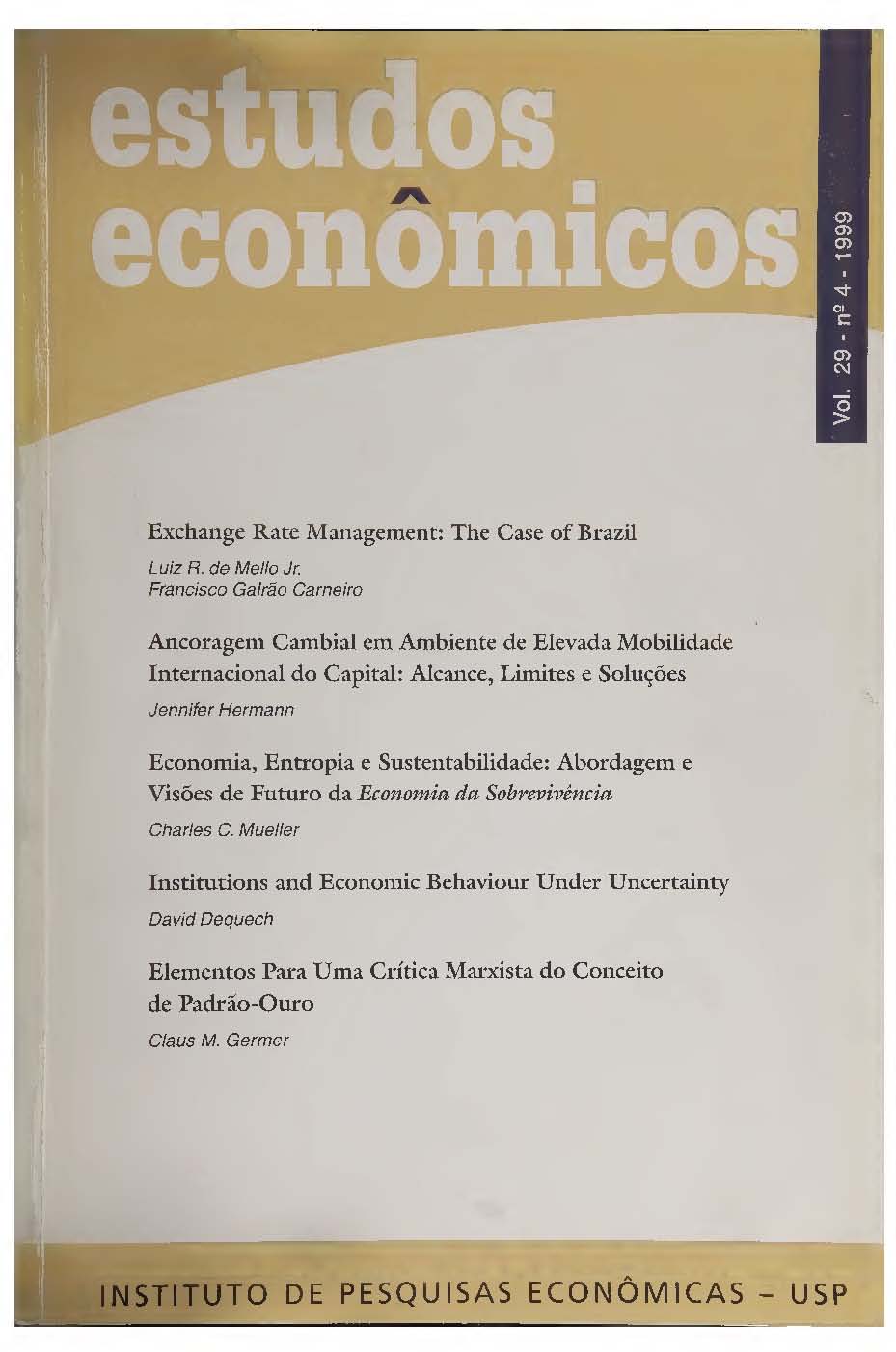Exchange rate management: the case of Brazil
Palavras-chave:
taxas de câmbio, modelos probit, BrasilResumo
O artigo apresenta um problema de escolha do regime de taxa de câmbio numa estrutura geral de precificação de títulos
Downloads
Referências
AGHEVLI, B. B, MOHSIN, S. K., AND MONTIEL, P. J. Exchange rate policy in developing countries; some analytical issues. IMF Occasional Papers N. 78, 1991.
BEVERIDGE, S., AND NELSON, C. A new approach to decomposition of time series into permanent and transitory components with particular attention to measurement of the business cycle. Journal of Monetary Economics, 7, p. 151-74, 1981.
CALVO, G. A., REINHART, C. M., AND VEGH, C. A. Targeting the real exchange rate: theory and evidence. Journal of Development Economics, 47, p. 97-133, 1995.
CARNEIRO, E G., DE MELLO, L. R. JR, AND TEIXEIRA, J. R. Temporal causality between the exchange rate and the trade balance: the case of Brazil. University of Kent at Canterbury, 1997, mimeo.
CATI, R. C; GARCIA, M. G. P. AND PERRON, P. Unit roots in the presence of abrupt governmental interventions with an application to Brazilian data. Journal ofApplied Econometrics, 14, p. 27-56, 1999.
COLLINS, S. M. On becoming more flexible: exchange rate regimes in Latin America and the Caribbean. Journal of Development Economics, 51, p. 117-38, 1996.
DIXIT, A. K., AND PINDYCK, R. S. Investment under uncertainty. Princeton: Princeton University Press, 1994.
EDWARDS, S. Real exchange rates, devaluation and adjustment: exchange rate policy in developing countries. Cambridge, MA: MIT Press, 1989.
EDWARDS, S. Exchange rates and the political economy of macroeconomic discipline. American Economic Review, 86, p. 159-63, 1996a.
EDWARDS, S. The determinants of the choice between fixed and flexible exchange rate regimes. NBER Working Paper N. 5756, 1996b.
ENDERS, WApplied econometric time series. John Wiley, 1995.
FERREIRA, A. H. B. Testes de Granger-Causalidade para a balança comercial brasileira. Revista Brasileira de Economia, p. 83-95, 1993.
FERILEIRA, F. V. Modelos monetarios da taxa de cambio nominal; testes de cointegração para o Brasil, 1986-1997. Anais do XXVI Encontro Nacional da ANPEC, v. 11, 1998, p. 745-764.
FERILEIRA, F. V. Modelos de bandas camhiais: uma aplicapdo ao caso hrasileiro. Disserta^
ao de Mestrado, UFRGS, 1999.
FLOOD, R. P., AND GARBER, P. M. A model of stochastic process switching. Econometrica, 51, p. 537-52, 1983.
FRANKEL, J. A. Recent exchange-rate experience and proposals for reform. American Economic Review, 86, p. 153-8, 1996.
NG, S. AND PERRON, P. Unit-root tests in ARMA models with data dependent methods for the selection of the truncation lag. Journal of the Amercican Statistical Association, 90, p. 268-81, 1995.
OZKAN, F. G., AND SUTHERLAND, A. Policy measures to avoid a currency crisis. Economic Journal, 105, p. 510-19, 1995.
ROSSI, J. O modelo monetario de determina^ao da taxa de cambio: testes para o Brasil. IPEA, Texto para Discussdo N. 393, 1995.
SACHS, J. D. Economic transition and the exchange rate regime. American Economic Review, 86, p. 147-52, 1996.
SUTHERLAND, A. State and time-contingent switches of exchange rate regime. Journal ofInternational Economics, 38, p. 361-74, 1995.
THIRLWALL, A. P. What is wrong with balance of payments adjustment theory? The Royal Bank of Scotland Review, 157, p. 3-19, 1988.
YOTOPOULOS, P. A. Exchange rate parity for trade and development. Cambridge: Cambridge University Press, 1996.
ZINI, A. & CATI, R. Cointegra^ao e taxa de cambio: testes sobre a PPP e os termos de troca no Brasil de 1855 a 1990. Pesquisa e Planejamento Economico, v. 23, n. 2, 1995.
Downloads
Publicado
Edição
Seção
Licença
Copyright (c) 1999 Luiz R. de Mello Jr., Francisco Galrão Carneiro

Este trabalho está licenciado sob uma licença Creative Commons Attribution-NonCommercial 4.0 International License.
A submissão de artigo autoriza sua publicação e implica o compromisso de que o mesmo material não esteja sendo submetido a outro periódico.
A revista não paga direitos autorais aos autores dos artigos publicados.
O detentor dos direitos autorais da revista é o Departamento de Economia da Faculdade de Economia, Administração, Contabilidade e Atuária da Universidade de São Paulo.




